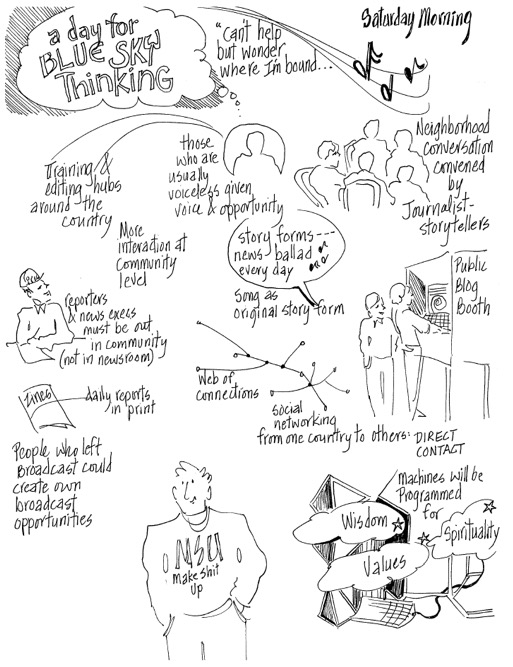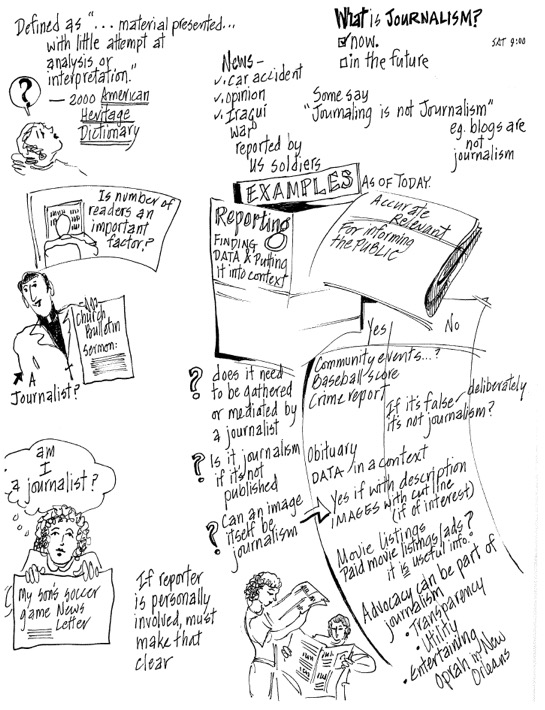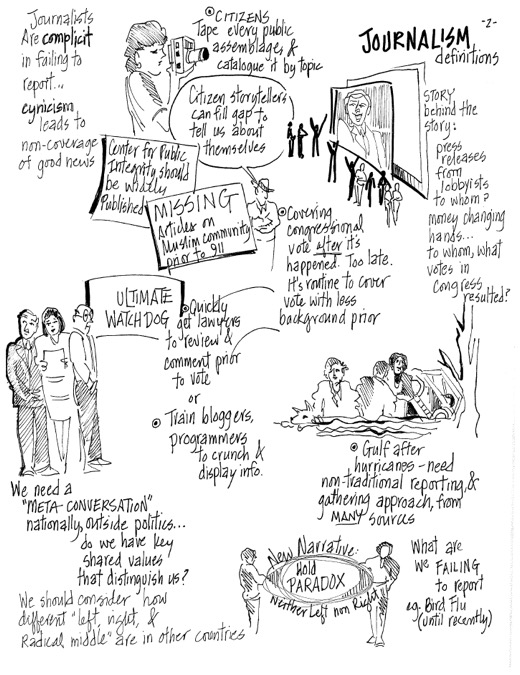Convener: Chris Peck
Participants:
Jane Stevens
Lisa Cohen (transcriber)
Lew Freidland
Florangela Davila
Ralph Gage
Duane
Michael VanBuren
Ken Berents
Cindy Zehnder
Nancy Margioles
Jan Shaffer
Vivian Jones
Michael
Melinda
Stacy Leach
Jean
Jim Shaffer
Sue Ellen Christian
Lew suggests buying a TV station and run it as a positive cash-flow generating model. 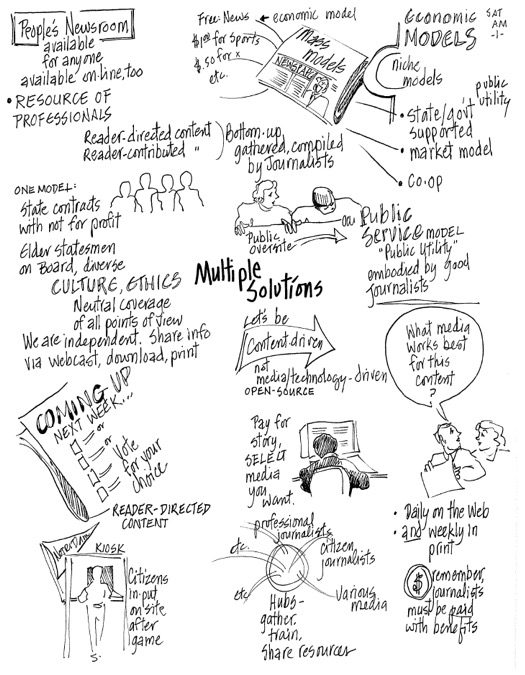 Experiment is to see whether you can do excellent journalism will people buy that paper or watch that station? If you cut out extra profit drained out by Wall Street, can you make enough to get by on? He believes yes.
Experiment is to see whether you can do excellent journalism will people buy that paper or watch that station? If you cut out extra profit drained out by Wall Street, can you make enough to get by on? He believes yes.
Ken asks how do you pay for it—especially as a broadcast property?
Lew has no problem with advertising…sell as much as you can within the limits of the quality of the product itself, and you might experiment with other possible revenue streams. Can bottom line sustain production? Can retention be maintained? Lew believes that Foundation support isn’t realistic. What about co-opting? It’s essentially a private-leveraged buy-out – Milwaukee Journal Sentinel is an example, though expansion leads to decision to raise public money. He wants a public trust with profit.
Chris suggests getting out other ideas.
Jan Shaffer says foundation support won’t happen. Reminds of Smithsonian Magazine is a private trust…makes a huge profit, and could grow it by putting it on the newsstand. She wonders why there isn’t more of a model for user fees…taxes on certain models, though there would have to be a public service component.
Chris agrees… go to a community, say you need local news and we’ve got to assess the community a certain amount for that, comparative to garbage, water etc. There would be a board assigned… not a hands-on board. Ken asks how to keep politics out of it? Chris says school boards are political, but able to deal with it. The fee is could be like a cable TV bill… could find a family-owned newspaper that would do there.
Jan says some papers do that Independent Newspapers who went to the IRS for a special exemption. Been in existence for 10 years.
Jonathon has 5 different models:
- Community-supported journalism i.e. Community radio, national grassroots, free speech radio, Democracy Now, etc. Paul Jay’s project “Independent World Television” Jay is out of Toronto and is launching a satellite new network with news out of Canada and India –will staff working news room. Funding model will be viewer-supported.
- Subscriber model like BBC
- Government supported – watch what’s going on in South America and Venezuela but counter-hegemonic to CNN
- Telesur will likely expand beyond S America
- Producer-owned blogs
- Public News Service – a national organization run out of Boulder, CO. print and radio journalists working in 16 states supported by community organization like unions, environmental groups, etc. Wire service reporting loosely steered by interest groups by editorially free. Offer items to newspapers and commercial radio stations.
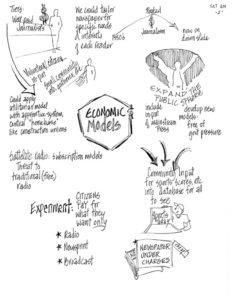 Stacy: Somehow we have to get consumers to pay for more of media. None of us want to be in a position to need a lot of money to have to get news, but she is suspicious of models that get to far away from a monetary connection with people who want to use it. What about a premium service for special news? Could be areas like sports and lifestyles subjects that they’re willing to pay more for? In addition to non-journalism related areas like selling archives. Has to be valuable to consumers. Papers are finding it increasing difficult People will pay $45 for Starbucks but not 75 cents for a paper. Times Select is now doing this. AJC has experimented with it, but it didn’t work.
Stacy: Somehow we have to get consumers to pay for more of media. None of us want to be in a position to need a lot of money to have to get news, but she is suspicious of models that get to far away from a monetary connection with people who want to use it. What about a premium service for special news? Could be areas like sports and lifestyles subjects that they’re willing to pay more for? In addition to non-journalism related areas like selling archives. Has to be valuable to consumers. Papers are finding it increasing difficult People will pay $45 for Starbucks but not 75 cents for a paper. Times Select is now doing this. AJC has experimented with it, but it didn’t work.
Jim Shaffer… adds “open source software model” where there are a few recognized high priests of standards but basically everyone contributes and there is a culture that establishes standards. If we buy something to experiment with it, let’s not tie ourselves to a medium…. Buy a “newsroom” and figure out how to adjust and disseminate information… open ideas. Take news piece and start from zero.
Duane talks historical models with ad –free newspapers Scripps “The Day Book” in 1910 in Chicago. Based on a penny a day from subscribers… didn’t make money in part because of newsprint costs, but were successful in offering other types of stories. Also “PM” in New York. Marshal Fields financed. Did news well, but there were organization problems getting items to premium subscribers. Introduced innovative things by reporting on other industries…again newsprint was critical cost.
Melinda says public radio has focused on diversification of funding. I.e. Starbucks, and fund drives. Especially local. Number is listeners People are paying stations. Stations are paying producers of content. Producers have diversified funding prospects from stations, donors, foundation. Underwriting, so if one piece drops out, you have other options to pick up.
Jane Stevens says the idea of buying a newsroom is a great idea because it addresses new mediums. Carefully determine pillars of information that you are going to cover. Let go of some subjects because they know other places do a better job and they can’t compete. Locally you can jettison national/international coverage unless is relates to local. With local emphasis you must consider state coverage… can local stations band together to cover the state capital? Can also add in Omai news model for individuals to offer payment. Jane feels local advertising is essential because it’s content and part of the conversation.
Jean Omai news model… consider idea of news as public utility. Lots of people are willing to contribute news and not work as full-time journalists. You might have a place of “Marketplace of Ideas” where people can vote for things they want covered. Check credibility will be assured by the governing body. Combine public utility idea with pay plan. Exploit people’s desire to be involved in production of news. Taxpayer money pays for level of news nobody wants to pay for but they need.
Karen (Beverly) is interesting in building on ascertainment model that requires some regular system that assesses what the community needs and if those needs aren’t met, there is someone who is accountable to make sure that happens. Combine that with open-source model.
Lew says difference between niche models (NPR, Times Select, Smithsonian) and mass models (includes local newspaper, buying a newsroom) Are mass model a state-supported model, a co-op model, a market model which journalists buy and run the institutions.
Chris says what if we go out and buy a newsroom tomorrow that is a free-floating form of journalists that can gather information and tells stories and can disseminate across many mediums.
Ken B asks whether the consumers even care?
Jan Shaffer says small “j” community” reader created and reader-directed content and thinks there is an electronic component that can be significant
Stacy is concerned with idea of “utility model” is a terrible idea because it brings to mind all of the negatives… arrogance, bureaucratic, etc. She doesn’t think it leads to less accountability. She says difference pricing plans are an option… but consumers need to be able to continue to call the shots and pull their support. Utility can be unresponsive.
Michael has different take. He thinks every institution has someone looking over their shoulder…whether stockholders, GM or whomever. With public utility there is at least a public utility is generally motivated by the idea that they’re serving the public.
Chris says get rid of the idea of public utility and change to public service. Now many media organization have to opt for best business decision in the short term,
Cindy says TVW is as close to that model as anyone in room. TVW doesn’t have an editorial policy, but they are not tool of one advocacy group or political party. State contracts with TVW to produce coverage. Board consists of political statesmen. They’ve learned they only succeed with they represent all viewpoints and don’t advocate.
Chris asks whether what we’re talking about here ultimately leads to CSPAN or whether there is a market for that? Cindy says TVW is a part of the overall mix of what’s offered.
Lisa News room idea can bring journalists and new media together form all stripes…. Let content drive the medium Ralph want to try hybrid “value-added” model – if he has a cable system in the community, that entitles you to print product with it and sell advertising (Gray Communications in Atlanta has a deal with Adelphia Cable) LA Times did that in Orange County and it worked.
Jean says making people pay for story makes people have a stake in story. Instead of passive, you become active member of the process. You are not paying for medium; you are paying for the story. Essentially becoming an investor in the story.
Jim agrees with Jean, says in Sunday paper, people can make choices and vote. Merge open source with utility is a clearinghouse. Ken says there isn’t good journalism in weekly papers. Florangela says we have to broaden our standards of acceptability. Maybe we need only niche papers.
Jane says we don’t need an actual room for a newsroom. Maybe just start on web or in a neighborhood in a metro area…start slow to get people to pay. Part of process is not just Big J journalism. Maybe could spin off print one day a week.
Ralph says that’s how they began with Laurence.com. Now they have a weekly paper delivered free and are daily on the web. Now they’re being invited into other towns.
Cindy says this is going to take multiple solutions. Some will work in some areas…others in other place and environments.
Melinda says if you take clearinghouse open-source ideas and training places that are just like hubs, but if there is a virtual newsroom but have a place to go to learn their craft. How can people come together and work together.
Chris asks if there can be template? At football game have people fill it in
Lew is concerned about labor economics. Most of us do value professionalism in journalism. That requires people to be paid and have health benefits. Lew is running workshops in Madison to learn journalism for neighborhood writers, but no one wants to read their stuff day in and day out.
Some of us can drop in and out but most need a salary. We won’t be able to support all of journalism without having some who are very skilled. So how do we support the full tier of journalism?
What if economics only allowed for one station/newspaper?
Cindy says this is the old building trades model… having an organization that supports your work and you may go out and contract your work but there is an organization that supports your work, that trainings and helps set standards and may help dispatch you to work. People play union dues for that and it works. Get apprenticeships, etc. Utilitarian model
Jonathon is concerned that the single newsroom idea which is limited to single editorial board which can be a problem. Also public broadcasting has been shrinking and funding is shrinking. It’s important to figure out ways to expand the public sphere starting with supporting political changes that bring more money into that sphere. CPB is a train wreck and needs reconstruction. Forget what has been the case… what should it look like? What are potential effective models? We need mainstream press to elevate that conversation.
Jane says combining experienced journalists with community journalists is being done in sports pages now in Laurence.
Duane says we do need advertising and remember advertising is content. An alternative could be that advertising has to meet certain criteria to pass muster. Duane thinks it’s possible without having heavy expenses on newsroom side.
Radio may be under the most pressure of all because of satellite competition. It’s being restructured as a subscription model.
What is you go to a community of about 10k without a dominant TV or newspaper or where it’s being done so poorly it needs competition. Set it up… we’re going to have a place where people can have a voice to vote on what they want to see… do low-power radio and TV service. Could be lots of fun.
PART TWO
Chris
How do we do this?
Young and experienced journalists want to do.
Some foundations want to do.
Let’s ID a community.
Lew
There are two models. There’s the small community bootstrap model (7,000 – 10,000), and a city model. Don’t want to leave the cities off the table. Care about urban journalism.
Chris
One model – nothing or done poorly.
Nongeographical model – some people organized or interested around something. Don’t necessarily live next to each other.
Lew
Urban model – the first one is buffalo. Has a terrible newspaper. Milking it as a cash cow. Jim has evidence. USA today has highest subscription rate of any city in the US. Buffalo has disinvested.
Second big city model – piecemeal invention. As part of the Trib. Reinventing reporting in West Oakland. Neighborhood based journalism. Hope that will lead to a more web-centric newsroom. Changing the newsroom by infiltrating upward.
Ralph
Community has identity but no local newspaper, or poor one, that’s an opportunity market.
Chris
How we would assess. What we would need to know. Would this plan make any difference?
Kent
Economic base, per capita income, Walmartization (eliminate competition, companies, newspapers don’t get advertising – some examples newspapers shut down to three or four days a week because of walmartization).
If you’re going to make a profit, decide. First year loss, 18-24 months out look for profit. Look for profit down the road – maybe not 15 percent, maybe two or five percent.
Only reason want to make a for profit, in case want to add. Start with five, go to six, need to make enough to go to six.
Chris
We want to have enough money to do what we want to do. One thing you’re saying to do that. Look at the community. The other thing we’ve talked about, do as utility, subscription model. What would that community look like?
Cindy
Don’t know about characteristics, but first thing is have conversation with community itself. Invest and be part of system they’re creating. I could see that one of things you would ask of town government, invest of public TV, record keeping so that people don’t have to go to meetings to find out what’s going on. So local govt. provides basics.
Chris
Get people together – do assessment. Here’s what we’re thinking of, we think there’s some value, need some investment. Tax or volunteers. What kind of commitment do you need from a community?
Beverly/Betsy
What are your consumption habits? What do you do? What do you want? Has to be analysis balance among use, do, consume or want. Go in there and ask what want and you decide how can provide that or if you can provide that.
Peggy
Convene a gathering people in community ask people what want. Provide you the guidance very quickly.
Jean
If you think people should support as public utility, talk about. Affinity group pays for topic, e.g. Smithsonian subscribers an affinity group.
Chris
Two interesting points. Doesn’t have to be dull as dishwater. There’s something about the added value make more interesting. ID aspects of community which have lot of passion.
Ralph
Do focus groups. Voters are readers.
Melinda
Care about water quality. Care about garbage collection. Make questions specific.
Chris
Do you go for community in which one or two things unique? Small town big college. Sailing community. Huge immigrant community.
Ralph
7500 circulation paper. A prison town. Lansing. Shawnee – 25,000 from. Started out was the western Shawnee dispatch. Postmaster, other community on other side of the highway that other newspaper doesn’t distribute to. Focus group. Went in there. City council like us. 100 year old Shawnee herald dispatch is no longer in existence. Quality you as public publication. You put out a decent newspaper, other people notice. We’ve had state legislators, saw what you did over there, why don’t you consider that over there. We have declined about four.
Peggy
We have been invited – key words. Something I know from my business.
Ralph
We take people with daily newspaper backgrounds, because they know journalism better than traditional weekly newspaper editor. Their experience so affirming, almost unbelievable. Not the reception in these communities, praise, etc., people operating newspapers overwhelmed about different response. That puts fun back in journalism.
Chris
There is a role for journalism. If you’re invited in. Love and forgiveness in journalism example. Here’s what you’re trying to do. We’re identifying four or five places want to go, are you interested? Now we’re at the point where we’re trying to identify the communities. Affinity groups, demographics.
Jim
Be cautious about doing focus groups in which people don’t know about it. Most innovation – ready, fire, aim. Try something, watch the results and then make the adjustments. Big biz – ready, aim, aim, aim, aim. Darwin tells us a diverse species has better chance of survival. We need a large number of experiments.
Peggy
Question for Ralph. If start as assumption that journalism is a conversation. Community component. What active involvement in what goes into this?
Ralph
It has been difficult to get citizen participation, even to the extent send us your press releases, and send us info about parent-teacher organization. They have a wait and see attitude. But have to remember people not used to being served this way.
Chris
One piece of it – journalists directed by the community. Go back to Jan’s idea of tiered content. Lowest level – sports scores, etc. Middle level.
Jean
Open source. Doesn’t have to be professional journalism. Something can be done themselves, like Oh My News has done. Tier – resource to be investing in story. Clearing house editor can assign.
Chris
Story comes in from the community. Lowest, needs vetting and editing. Middle
Nora
What if the news organization owned places were owned by newspapers, waiters were reporters? South America town – every fourth storefront internet café. Terminals and coffee bar.
Chris
It’s another revenue source. Create a gathering place, fun place.
Jim
Put kiosk in bar, mall, etc.
Kent
Wi-fi them all.
Melinda
StoryCorps on NPR.
Peggy
Something interesting about journalism owning community gathering place. First place family, second place work, you need a third place.
Jonathan
Bought post office building in Urbana Champaign, independent media center. Publishing a newspaper, community wi-fi project. Setting up free wi-fi around the city to create community network that everyone can get on. Community journalism model, particularly wi-fi – cheaply bring communications to poor communities in west Chicago or rural.
Kent
In Charleston, SC, they’re starting a joint venture where when you come into smash you click on wi-fi, automatically get web site. One of problem is low penetration in newspaper. Help build your brand. Advertisers are moving towards online, if they could get more branding with local paper, I’m going to advertise some more.
Beverly/Betsy
Barriers for entry. Wi-fi good if you have a laptop. MIT 100 dollar laptop. That gives me more comfort. Training.
Nora
IN cities, revitalize downtown corps that might bring in other businesses.
Peggy
Five six restaurants around common area.
Lew
Philly is now probably about to roll out wi-fi around west Philly, underserved area. Also underserved by Inquirer and daily news. Temple project – doing reporting. North Philly big community 250,000/300,000 city that’s as underserved as communities Ralph goes into. Other than shootings or cop stories, sees next to nothing. A whole another model, community reinvestment. Building a daily report on top of other things.
Beverly/Betsy
Tiers – there need to be opportunities to move up and out. Also need to be opportunities to incorporate different types of storytelling – chanters, songwriters.
Chris
If you have a café, sing a song, write a poem, and link that up with informing people.
Cindy
I’m interested in getting info to people to empower people to participate in how they’re governed. A state where geographic barriers, how do you bring them in to decision-making places. We’re giving people live video or ability to testify via
Chris
Saving North Dakota model. Newspaper set up groups why young people leaving ND. Partnered with public TV and legislature. That broadcast across TV and asked legislators to watch.
Cindy
More direct example. Debate on blanket primary. Covered it live. Rep. invited public TV audience to send in questions and comments became part of the legislative conversation.
Chris
You’re a convener as well. Partnerships to help have discussion.
Peggy
It’s moving in both spectrums – higher tech and more high touch. There’s something about doing journalism through the arts, going back to oral traditions.
Chris
Not forcing it into ink on paper.
Duane
Resources in older people in community. Large retirement community – ready to learn and contribute. Need meaning in life more than money.
Chris
Have to have bodies, money. Let’s think about resources. People who living where we want to be. Retirees. Young people. Another one, journalist old system not for me. Be able to drop in. Might live there. Business experience retired or doing something outside. Journalism educators going on sabbatical.
Beverly/Betsy
Where are worker protections?
Chris
If you can’t do it, then don’t do it. I think this next phase bring health plan/retirement plan. It’s an entrepreneurial experience. I don’t think we try to get people free.
Melinda
Who invests?
Duane
Invest, have stake.
Kent
In local cities, people buy in stock in a local bank. As big banks consolidate, small local banks starting up.
Chris
Funding and then pick a town. We say to local people, go to tax paying entity, say help us. This is the utility model. We’re going to go someplace, in return for voice, you invest in it. We talked about small banks. Take out a loan.
Kent
Sell community shares.
Chris
Mechanisms through small business. Forming a coop.
Kent
Talk about developing a business model. All in an offering circular as key selling points,
Chris
Individual investors who might like to do it.
Kent
I’m fed up with what the local papers; I’m willing to cough up.
Cindy
May get support from local unions.
Chris
Oxford, Mississippi. Not a good newspaper sitting there.
Jonathan – Vancouver, BC
Jim – Cape Cod, non geographic and geographic community
Jean – Seoul
Lew – Buffalo, Madison
Melinda – St. Louis
Nora – Kalamazoo
Sue Ellen – Bent Harbor, Holland Michigan
Karen – Gary, Indiana and seniors
Silja – immigrant and communities of color
Cindy – Walla Walla, WA
Kent – Charlottesville and Williamsburg, VA
Michael – Battle Creek, MI
Duane – Goshen, Indiana
Ralph – student/youth roll into
Jane – West Oakland. Paris, France
Lisa –Walla Walla, WA; Florence, Italy

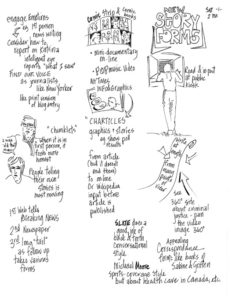

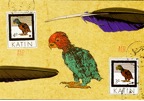
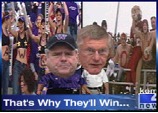
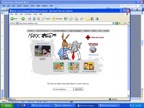
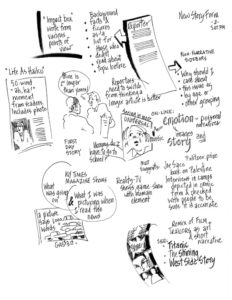
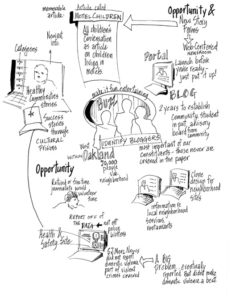

 Experiment is to see whether you can do excellent journalism will people buy that paper or watch that station? If you cut out extra profit drained out by Wall Street, can you make enough to get by on? He believes yes.
Experiment is to see whether you can do excellent journalism will people buy that paper or watch that station? If you cut out extra profit drained out by Wall Street, can you make enough to get by on? He believes yes. Stacy: Somehow we have to get consumers to pay for more of media. None of us want to be in a position to need a lot of money to have to get news, but she is suspicious of models that get to far away from a monetary connection with people who want to use it. What about a premium service for special news? Could be areas like sports and lifestyles subjects that they’re willing to pay more for? In addition to non-journalism related areas like selling archives. Has to be valuable to consumers. Papers are finding it increasing difficult People will pay $45 for Starbucks but not 75 cents for a paper. Times Select is now doing this. AJC has experimented with it, but it didn’t work.
Stacy: Somehow we have to get consumers to pay for more of media. None of us want to be in a position to need a lot of money to have to get news, but she is suspicious of models that get to far away from a monetary connection with people who want to use it. What about a premium service for special news? Could be areas like sports and lifestyles subjects that they’re willing to pay more for? In addition to non-journalism related areas like selling archives. Has to be valuable to consumers. Papers are finding it increasing difficult People will pay $45 for Starbucks but not 75 cents for a paper. Times Select is now doing this. AJC has experimented with it, but it didn’t work.